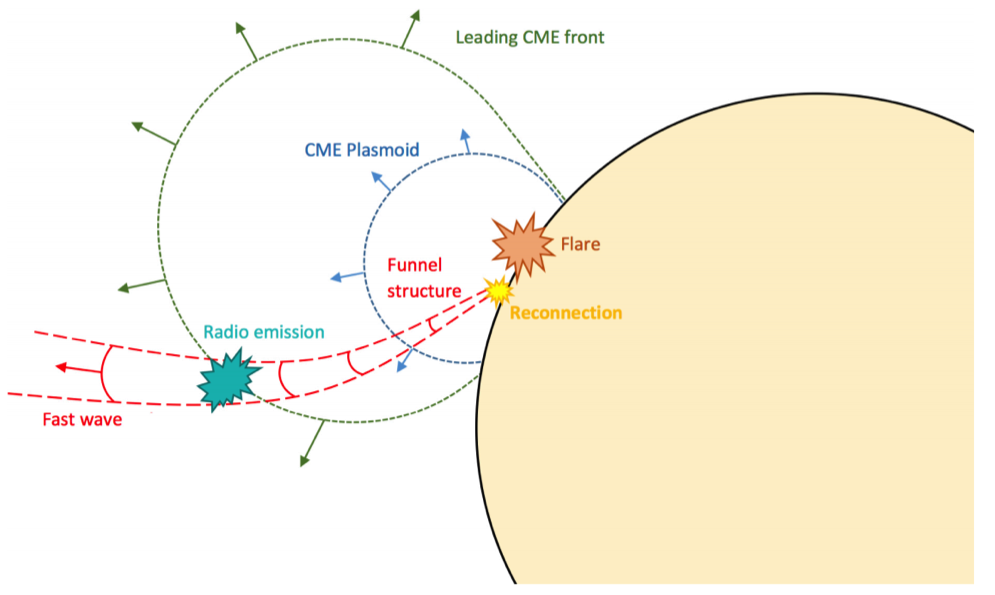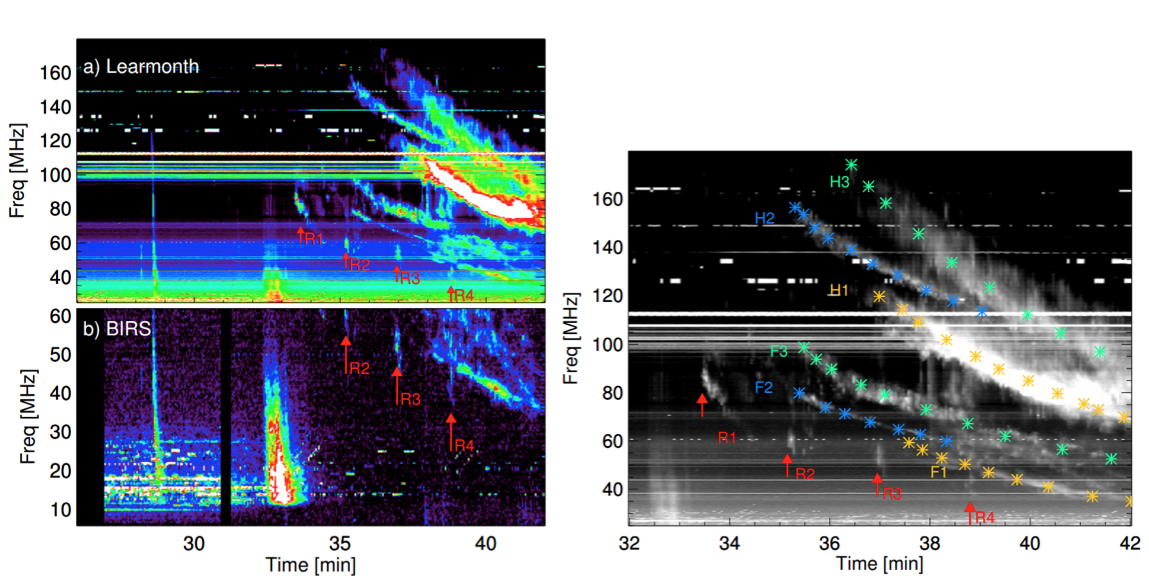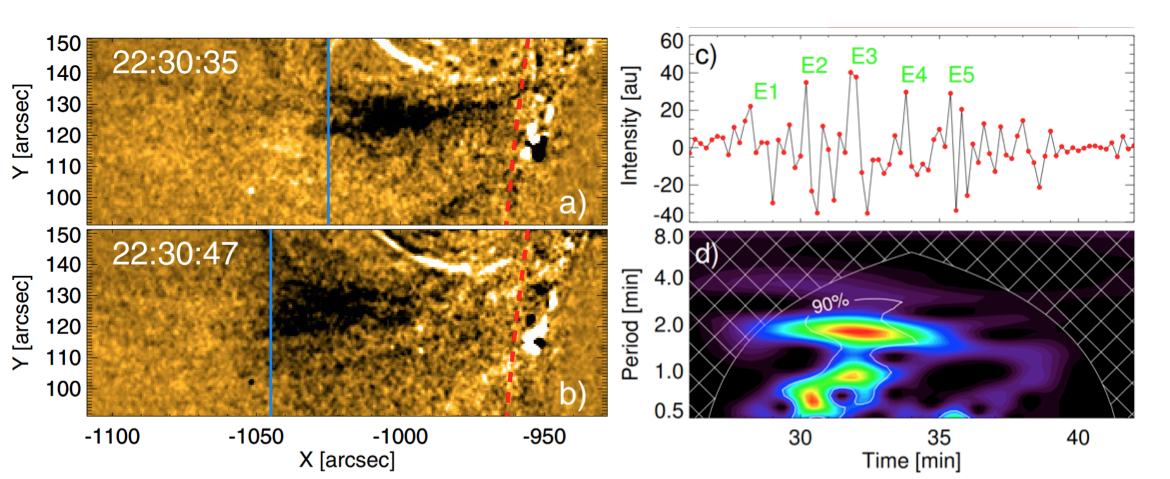Observation of quasi-periodic solar radio bursts associated
with propagating fast-mode waves
by C. R. Goddard et al.*
2017-01-03Solar Radio Science Highlights
Flaring activity on the Sun triggers waves and oscillations in the solar corona. The study of these waves and oscillations allows comparisons to magnetohydrodynamic (MHD) theory and modelling to be made, and seismological inversions based on this comparison allow local plasma parameters to be measured indirectly (e.g. De Moortel & Nakariakov 2012).
Simultaneous EUV imaging and radio observations make it possible to study how these waves and oscillations can produce or modify radio emission from the coronal plasma. One of the most intensively studied examples of this are type II radio bursts, which are observed during coronal mass ejections (CMEs) (e.g. Pick & Vilmer 2008). Coronal type II radio bursts are usually seen as two locally-parallel emission lanes on solar radio spectrograms with an instant frequency ratio of approximately 2, drifting from high to low frequencies over time. It is generally accepted that this radio emission is a result of plasma wave excitation at fronts of MHD shock waves propagating upwards through the corona. The lower and higher frequency lanes are thought to be emission at the fundamental and second harmonic of local plasma frequency, respectively
We analysed an individual flaring event, SOL2014-11-03T22:15, the subsequent CME and wave activity and the associated type II burst. We found evidence that a series of quasi-periodic ‘sparks’ in the radio spectra are linked to disturbances seen in the low corona in the EUV band. This is the first observation which links quasi-periodic fast waves of the EUV intensity to quasi-periodic features in radio spectra.

Figure
1. A schematic synopsis of the event. A flare occurs which is followed
by a CME comprising of the leading edge or EUV wave (green) and the main
CME plasmoid (blue). A funnel structure (red) within the active region
is seen to host a series of rapidly propagating quasi-periodic waves. A
brightening is observed at the base of this structure and is interpreted
as a reconnection site where the waves are impulsively excited. After a
certain delay periodic radio sparks are observed, which occur at an
estimated height consistent with the leading feature of the CME, and a
periodicity consistent with the fast wave period.
Periodic signatures in radio and EUV emission

Figure 2. Left: Learmonth (top) and
BIRS (bottom) radio spectra in the ranges 25-170 MHz and 5-50 MHz
respectively. Four regions of enhanced emission are indicated by R1-R4.
Right: A zoomed region of the Learmonth spectra highlighting the radio
sparks as well as the three fundamental and harmonic emission lanes
of the type II burst.
A series of periodic ‘radio sparks’
(finite-bandwidth, short-duration isolated radio features) were detected
in both the Learmonth and BIRS dynamic spectra. They preceded a
split-band type II burst consisting of three fundamental lanes and their
second harmonic counterparts (Figure 2). Four radio sparks were
detected with a period of 1.78±0.04 min, with the first spark occurring
at 22:33 UTC. Their central frequencies drift from high to low
frequencies in the same manner as the type II lanes.
EUV imaging from SDO/AIA identified a
series of quasi-periodic rapidly propagating enhancements (Figure 3),
which we interpret as a fast wave train. These propagate upwards into
the corona along a guiding plasma structure. At least five enhancements
were detected, with a period of 1.7 ±0.2 min, starting at 22:28 UTC.
These waves occur after part of the CME plasmoid has interacted with the
base of the plasma funnel, potentially resulting in magnetic
reconnection in that region.

Figure
3. Left: Two running-difference snapshots of the periodic fast waves
detected in the EUV images. The vertical blue lines indicate the
position of the wave front. Right: An intensity time series extracted at
one position along the path of the fast waves. The periodic
enhancements are labelled as E1-E5. Below is the wavelet spectra of the
time-series, showing the main periodicity of just under 2 mins.
Unfortunately, no spatially-resolved
observations of the radio sources are available for this event,
therefore our analysis was restricted to the radio spectra. From the
central frequency of the radio sparks the local electron density at the
emission location is calculated for each. The electron density
calculated by an empirical formula, was used to obtain the height above
the surface at which the emission occurs, and the propagation speed of
the radio emission location. The emission heights derived coincide
roughly with the forward-projected location of the leading edge of the
CME. The inferred propagation speed of 630 km s−1, is comparable to the measured speed of the CME leading edge, 500 km s−1, and the speeds derived from the drifting of the type II lanes.
Physical Scenario
Due to the matching periods, we consider
the radio sparks to be caused by the periodic fast waves observed in
the EUV band. This is supported by the time offset between the
observations, due to the time taken for the fast waves to reach the
height at which the radio emission is generated. The height of the radio
source and its speed approximately match the height and velocity of the
leading CME feature.
We interpret our observations with the
following physical scenario (Figure 1). A series of fast waves are
produced in the active region during a flare, during an observed
magnetic reconnection event triggered by the CME. The waves propagate
upwards along a funnel plasma structure, and interact with the CME
leading edge, or some associated disturbance that propagates slower than
the fast wave train. This results in the acceleration of electrons, the
bump-on-tail instability, and emission of radio waves with the
frequency corresponding to the local electron plasma frequency,
appearing as quasi-periodic sparks in the radio spectrograph. However,
proper theoretical modelling of the process is needed.
Summary
The period of a series of radio sparks
which precede a type II burst, 1.78±0.04 min, matches the period of a
fast wave train observed at 171 Å, 1.7 ±0.2 min. The inferred speed of
the emission location of the radio sparks, 630 km s−1, is comparable to the measured speed of the CME leading edge, 500 km s−1,
and the speeds derived from the drifting of the type II lanes. The
calculated height of the radio emission matches the observed location of
the CME leading edge. From the above evidence we propose that the radio
sparks are caused by the quasi-periodic fast waves, and the emission is
generated as they catch up and interact with the leading edge of the
CME (Figure 1).
Based on the paper:
Goddard,
C., Nisticò, G., Nakariakov, V., Zimovets, I., & White, S. (2016).
Observation of quasi-periodic solar radio bursts associated with
propagating fast-mode wavesAstronomy & Astrophysics, 594DOI:10.1051/0004-6361/201628478
References
[1] C. R. Goddard, G. Nisticò, V. M. Nakariakov, I. V. Zimovets and S. M. White,2016, A&A, 594, A96
[2] De Moortel, I. & Nakariakov, V. M.2012, Royal Society of London Philosophical Transactions Series A, 370, 3193
[3] Pick, M. & Vilmer, N.2008, A&A Rev., 16, 1
*Complete list of authors:C. R. Goddard, G. Nistico, V. M. Nakariakov, I. V. Zimovets, and S.M. White
